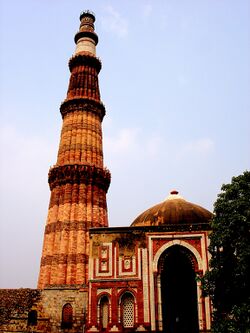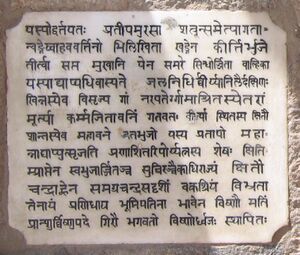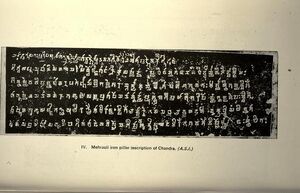Mehrauli
For Mahroli village in Sikar district (Rajasthan), please click here → Mahroli

Mehrauli (महरौली) village in Delhi needs no introduction. It is an ancient Jat village, famous for its UNESCO world heritage site, Qutub Minar, which, contrary to current theory, was built either in the times of Prithvi Raj Chauhan or even earlier, in memory of famous Astronomer, Varahamihira. Mehrauli's original name is Mihirawali, meaning "in the memory of Mihira (Varahamihira). Mehrauli has rich history which can be found in various textbooks. Mehrauli is known in history for the iron pillar inscription. This iron pillar bearing the inscription of Chandra was originally erected on a hill called Visnupada near the Beas, but was brought to Meharauli (Delhi) and was installed near the well-known Kutub Minar. We also know of the transfer of the Ashokan pillars from Topra and Meerut to Delhi.[1]
Variants
- Maharauli महरौली (AS, p.720)
- Mihirapuri (मिहिरपुरी) (AS, p.720)
- Miharapuri मिहरपुरी दे. Mahrauli महरौली (p.747)
Jat gotras in Mehrauli
Notable Jats from Mehrauli village
- Satbir Singh Gandas Mayor Delhi
- Pushpa Satbir Singh Mahila Congress President
History
Ram Sarup Joon[2] writes that ....Chandra Gupta II (Vikramaditya) annexed Gujrat and Kathiawar and extended the already large Gupta Empire. He created the famous Iron pillar at Mehrauli, (New Delhi) which, apart from commemorating his rule, is a fine example of sophisticated metallurgy.
The Chinese traveler Fa Hein, during his travels, stayed for 3 years in Patliputra. He has praised the administration of Gupta Rule.
The following inscription has been made on the Iron Pillar, -
- (The King) whose sword had eternal glory. He subjugated the enemy in Bengal and ruined them who had congregated against the king. He has crossed the seven riverbeds of Indus and conquered the country. The breeze of Southern Sea has been full of fragrance due to his chivalry. He left the world for eternal abode reluctantly. He reached the Paradise created by his own noble deeds. His name is surviving in the world due to this glory. His blood drawn might' has not yet subsided from the earth like. The heat of "huge and tangled jungle fire. He maintained his emperorship for ages, which he achieved with his might. His name 'Chander' having a moon likes bloom on his face. He was an Emperor, of this world and was a staunch 'Bhakta of Vishnu God. He put' this huee pillar as a symbol of Vishnu on the hill (Vishnu Pad).
महरौली
महरौली (AS, p.720): दिल्ली से 13 मील दूर छोटा सा कस्बा है. पृथ्वीराज चौहान (12 वीं सदी का अंत) के समय की दिल्ली इसी स्थान के निकट थी. पृथ्वीराज की अधिष्ठात्री देवी जोगमाया का मंदिर भी यहां है. इसी मंदिर के कारण दिल्ली का एक मध्यकालीन नाम जोगिनीपुर भी प्रसिद्ध था. गुलाम-वंश के सुलतानों की दिल्ली भी महरौली के आसपास बसी हुई थी. कुतुबमीनार के निकट प्रसिद्ध लोहस्तंभ है जिसका गुप्तकालीन अभिलेख - महरौली स्तंभ अभिलेख कहलाता है. इसमें चंद्र (शायद चंद्रगुप्त द्वितीय) नामक राजा की विजय यात्राओं तथा मरणोत्तर कीर्ति का यशोगान है (देखें दिल्ली). कुछ विद्वानों का कहना है कि महरौली में प्राचीन काल में वेधशाला थी और इसी कारण महरौली या मिहिरपुरी मिहिर या सूर्य के नाम पर प्रसिद्ध थी.
पुष्करण
विजयेन्द्र कुमार माथुर[3] ने लेख किया है ..... 2. पुष्करण (AS, p.571): पुष्करारण्य: मारवाड़ का प्रसिद्ध प्राचीन स्थान है. श्री हरप्रसाद शास्त्री के अनुसार महरौली (दिल्ली) के प्रसिद्ध लोहा स्तंभ पर जिस चंद्र नामक राजा की विजयों का उल्लेख है वह पुष्करण का चंद्रवर्मन् है. यह चंद्रवर्मन् 404-405ई. के मंदसौर अभिलेख में उल्लिखित है. श्री शास्त्री के अनुसार समुद्रगुप्त की प्रयाग प्रशस्ति का चंद्रवर्मन् भी यही है. यह नरवर्मन् का भाई था और यह दोनों मिलकर मालवा तथा परिवर्ती प्रदेश पर राज्य करते थे. पुष्करण या पोखरण कर्नल टॉड के समय (19 वीं सदी का प्रथम भाग) तक मारवाड़ की एक शक्तिशाली रियासत थी. (देखें अनाल्स ऑफ राजस्थान, पृ. 605). पोखरण का प्राचीन नाम पुष्करण या पुष्करारण्य था. इसका उल्लेख महाभारत में है.... सभा पर्व है 32,8-9 इस स्थान पर पुष्करारण्य का उल्लेख माध्यमिका या चित्तौड़ के पश्चात होने से इसकी स्थिति मारवाड़ में सिद्ध हो जाती है. यहां के उत्सवसंकेत गणों को नकुल ने दिग्विजय यात्रा के प्रसंग में हराया था.
दिल्ली
विजयेन्द्र कुमार माथुर[4] ने लेख किया है ... हर्ष के साम्राज्य के छिन्न-भिन्न होने के पश्चात उत्तरी भारत में अनेक छोटी-छोटी रियासतें बन गई और इन्हीं में 12 वीं सदी में पृथ्वीराज चौहान की भी एक रियासत थी जिसकी राजधानी दिल्ली बनी. दिल्ली के जिस भाग में क़ुतुब मीनार है वह अथवा महरौली का निकटवर्ती प्रदेश ही पृथ्वीराज के समय की दिल्ली है. वर्तमान जोगमाया का मंदिर मूल रूप से इन्हीं चौहान नरेश का बनाया हुआ कहा जाता है. एक प्राचीन जनश्रुति के अनुसार चौहानों ने दिल्ली को तोमरों से लिया था जैसा कि 1327 ई. के एक अभिलेख से सूचित होता है--'देशोस्ति हरयाणाख्य: पृथिव्यां स्वर्गसन्निभ:, ढिल्लिकाख्या पुरी यत्र
[p.435]: तोमरैरस्ति निर्मिता। चहमाना नृपास्त्र राज्यं निहितकंटकम्, तोमरान्तरम् चक्रु: प्रजापालनतत्परा:'
यह भी कहा जाता है कि चौथी सदी ईस्वी में अनंगपाल तोमर ने दिल्ली की स्थापना की थी. इन्होंने इंद्रप्रस्थ के किले के खंडहरों पर ही अपना किला बनवाया. इसके पश्चात इसी वंश के सूरजपाल ने सूरजकुंड बनवाया जिसके खंडहर तुगलकाबाद के निकट आज भी वर्तमान हैं. तोमर वंशीय अनंगपाल द्वितीय ने 12 वीं सदी के प्रारंभ में लाल कोट का किला कुतुब के पास बनवाया. तत्पश्चात दिल्ली बीसलदेव चौहान तथा उनके वंशज पृथ्वीराज के हाथों में पहुंची. जनश्रुति के अनुसार क़ुतुब मीनार और कुव्वतुल इस्लाम मस्जिद पृथ्वीराज के इस स्थान पर बने हुए 27 मंदिरों के मसालों से बनवाई गई थी.
कुछ विद्वानों का मत है कि महरौली जहां कुतुब मीनार स्थित है-- पहले एक वृहद वेधशाला के लिए विख्यात थी. 27 मंदिर 27 नक्षत्रों के प्रतीक थे और कुतुब मीनार चांद-तारों आदि की गतिविधि देखने के लिए वेधशाला की मीनार थी. इन सभी इमारतों को कुतुबुद्दीन (r. 1206-1210) तथा परर्वती सुल्तानों ने इस्लामी इमारतों के रूप में बदल दिया. पृथ्वीराज के तराइन के युद्ध में (1192 ई.) मारे जाने पर दिल्ली पर मुहम्मद गोरी (1149 – 1206) का अधिकार हो गया. इस घटना के पश्चात लगभग साढ़े 6सौ वर्षों तक दिल्ली पर मुसलमान बादशाहों का अधिकार रहा और यह नगरी अनेक साम्राज्यो की राजधानी के रूप में बसती और उड़ती रही. मुहम्मद गौरी के पश्चात 1236 ई. में गुलाम वंश की राजधानी दिल्ली में बनी. इसी काल में कुतुब मीनार का निर्माण हुआ. गुलाम वंश के पश्चात अलाउद्दीन (r. 1296 to 1316) ने सीरी में अपनी राजधानी बनाई.
दिल्ली के प्राचीनतम स्मारकों में महरौली में स्थित चंद्र नाम के किसी यशस्वी नरेश का विष्णुध्वज लोहस्तंभ सबसे अधिक प्रसिद्ध है. इस पर निम्न अभिलेख उत्कीर्ण है--
|
| महरौली स्थित चंद्र का लोहस्तंभ अभिलेख [5] |
चंद्र का अभिज्ञान चंद्रगुप्त द्वितीय से किया जाता है किंतु यह तथ्य विवादास्पद है. कहा जाता है कि पृथ्वीराज के नाना अनंगपाल ने यह लोह-स्तंभ मथुरा से लाकर यहां स्थापित किया था. यह स्तंभ सैकड़ों वर्षों से खुले हुए स्थान में बिना जंग खाए हुए खड़ा हुआ है. यह एक ही लोहे के खंड का बना है. इतना बड़ा लोह-दंड ढालने की निर्माणियां भारत में चौथी सदी ई. में थी यह जानकर प्राचीन भारत के धातु-कर्म-विशारदों के प्रति हमारा मस्तक आदर से झुक जाता है. कहा जाता है कि इस परिमाण का लोह-दंड इंग्लैंड तक में 19 वीं शती के प्रारंभ से पूर्व नहीं ढाला जा सकता था.
बाह्लिक = वाह्लिक
विजयेन्द्र कुमार माथुर[6] ने लेख किया है .....बाह्लिक = वाह्लिक (AS, p.626): 'केराता: दरदा दार्वाः शूरा वैयमकास तथा, औदुम्बरा दुर्विभागाः पारदा बाह्लिकैः सह. महा.सभा 52,13. बाह्लिक या वाह्लिक, बल्ख (=ग्रीक बेक्ट्रिया) का प्राचीन संस्कृत नाम है. यहां के निवासी युधिष्ठिर के राजसूय यज्ञ में भेंट लेकर आए थे. महरौली लौह स्तंभ के अभिलेख में चंद्र द्वारा सिंधु नदी के सप्तमुखों के पार वाह्लिकों के जीते जाने का उल्लेख है--'तीर्त्वा सप्त मुखानि येन समरे सिन्धोर्जिता-बाल्हिका:' जिससे गुप्त काल में वाह्लिकों की स्थिति सिंध नदी के मुहाने के पश्चिम में सिद्ध होती है. जान पड़ता है कि इस काल में बल्ख के निवासियों ने अपनी बस्तियां इस इलाके में बना ली थी. महाभारत कर्ण पर्व में संभवत: वाहीक नाम से ही वाह्लिक निवासियों का उल्लेख है. (देखें वाहीक, वाह्लिक, वाल्हिक, बाह्ली)
Mehrauli Iron Pillar Inscription of Chandragupta II

The iron pillar of Delhi, India is a 7 meter (22 feet) high pillar in the Qutb complex which is notable for the composition of the metals used in its construction.
The pillar, almost seven meters high and weighing more than six tons, was erected by Chandragupta II Vikramaditya (375 CE–414 CE), (interpretation based on analysis of archer type Gupta gold coins) of the Gupta dynasty that ruled northern India 320–540.[7] The pillar with the statue of Chakra at the top was originally located at a place called Vishnupadagiri (meaning “hill with footprint of Lord Vishnu”).[8] This has been identified as modern Udayagiri, situated in the vicinity of Besnagar, Vidisha and Sanchi. These towns are located about 50 kilometres east of Bhopal, in central India. There are several aspects to the original site of the pillar at Udayagiri. Vishnupadagiri is located on the Tropic of Cancer and, therefore, was a centre of astronomical studies during the Gupta period. The Iron Pillar served as a sundial when it was originally at Vishnupadagiri. The early morning shadow of the Iron Pillar fell in the direction of the foot of Anantasayin Vishnu (in one of the panels at Udayagiri) only around the summer solstice (June 21). The Udayagiri site in general, and the Iron Pillar location in particular, are evidence for the astronomical knowledge that existed in Gupta India.

The pillar bears a Sanskrit inscription in Brahmi script which states that it was erected as a standard in honour of Lord Vishnu. It also praises the valor and qualities of a king referred to simply as Chandra, who has been identified with the Gupta King Chandragupta II Vikramaditya (375-413). The inscription reads (in the translation given in the tablets erected by Pandit Banke Rai in 1903):
- He, on whose arm fame was inscribed by the sword, when, in battle in the Vanga countries (Bengal), he kneaded (and turned) back with (his) breast the enemies who, uniting together, came against (him);-he, by whom, having crossed in warfare the seven mouths of the (river) Sindhu, the Vahlikas were conquered;-he, by the breezes of whose prowess the southern ocean is even still perfumed;-
- (Line 3.)-He, the remnant of the great zeal of whose energy, which utterly destroyed (his) enemies, like (the remnant of the great glowing heat) of a burned-out fire in a great forest, even now leaves not the earth; though he, the king, as if wearied, has quit this earth, and has gone to the other world, moving in (bodily) from to the land (of paradise) won by (the merit of his) actions, (but) remaining on (this) earth by (the memory of his) fame;- (L. 5.)-By him, the king,-who attained sole supreme sovereignty in the world, acquired by his own arm and (enjoyed) for a very long time; (and) who, having the name of Chandra, carried a beauty of countenance like (the beauty of) the full-moon,-having in faith fixed his mind upon (the god) Vishnu, this lofty standard of the divine Vishnu was set up on the hill (called) Vishnupada.
Excerpts from Delhi Gazeteer 1912
See the following link (Page No. 220)- http://revenueharyana.gov.in/html/gazeteers/Delhi%20Gazeetter%201912.pdf
Mahrauli is a small town 11 miles from Delhi on the metalled road to Gurgaon, with, a present population of about 3,883. It is prettily situated in the low hills of which the ridge is the continuation and is built on either side of the main road which, in an inconveniently narrow form, is its main street, There is here a camping-ground, thana, dispensary, an excellent dak bungalow with considerable accommodation, and a rest-house for district officers in the building known as Adham Khan's tomb. The place is locally famous for the Pankha Mela which takes place in August and on which occasion the Hindus and Muhammadans on successive days form processions in which the pankhas or banners of special design are paraded down the main street. At this time the town is visited by large crowds and the houses, usually empty, are filled to overflowing. Here too there is a well known Hindu Temple devoted to the worship of Jogi Maya, the approach to which has been recently beautified by the munificence of the late Rai Bahadur Hardyan Singh. Mahrauli has always been, a sanitarium for residents of Delhi and it is a pleasant place in which to spend a week-end, the air being fresh and cooler than in the city. Sir Thomas Metcalfe himself had a retreat, the buildings of which are now in a ruined state: the gates of the 221 compound are clearly marked by the very English-looking gate-posts. Mahrauli is of world-wide historical interest owing Places of to the presence of the Kutb Minar and is the centre of many old ruins both within the Kila Rai Pithora and without. The walls and keep of the Kila (fort) are well defined enclosing as they do about 2 square miles of country. An excellent plan of this neighborhood and descriptions of the various objects of interest are to be found in Fanshawe's "Delhi Past and Present," Chapter V. The principal objects of interest outside the old fort boundary are the Dargah Kutb Sahib, the Hauz Shamsi, the Jherna garden and the Jahazi Mosque. The Dargah is the resort of pious Muhammadans and contains many graves of interest: the Majawars who are hereditary guardians of the shrine receive the revenue of Mahrauli, some Rs. 2,000, for their services. The Hauz Shamsi is an old tank, situated in a natural depression, which has recently been cleaned out as a famine work and it has always been used as the water supply for the Jherna gardens, a weird spot recalling Rider Haggard’s Romances. The Jahazi or (ship) Mosque has the legend attached to it that a pious merchant vowed to build 11 mosque if his ship came safely to port. The "doli (well) too is interesting: a local family make a livelihood by dropping down the well in return for the bakhshish of sight-seers. The Municipal income is about Rs. 1,700 per year, the income tax assessment is Rs. 280, and the land revenue mostly assigned to the Dargah amounts to Rs. 2,200.
Gotra
- Sehrawat<ref>जाट वीरों का इतिहास: दलीप सिंह अहलावत (एकादश अध्याय) (पृष्ठ संख्या 1024)</ref
- Gandas
See also
- More info on Jatland Wiki at - Personal and geographical names in the Gupta inscriptions/I A Note on the King Candra of the Meharaull Iron Pillar Inscription
External links
References
- ↑ Personal and geographical names in the Gupta inscriptions by Tej Ram Sharma, p.309
- ↑ History of the Jats/Chapter IV ,p. 58-59
- ↑ Aitihasik Sthanavali by Vijayendra Kumar Mathur, p.570-571
- ↑ Aitihasik Sthanavali by Vijayendra Kumar Mathur, p.434-436
- ↑ Aitihasik Sthanavali by Vijayendra Kumar Mathur, p.436
- ↑ Aitihasik Sthanavali by Vijayendra Kumar Mathur, p.626
- ↑ Identity of Chandra and Vishnupadagiri of the Delhi Iron Pillar Inscription: Numismatic, Archaeological and Literary Evidence, R Balasubramaniam, Bulletin of Metals Museum, 32 (2000) 42–64.
- ↑ On the Astronomical Significance of the Delhi Iron Pillar, R Balasubramaniam and Meera I Dass, Current Science, volume 86 (2004) pp. 1134–1142.[1]
Back to Jat Villages

